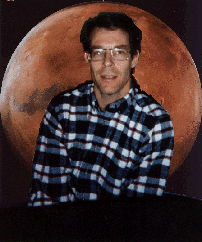 Davis, Calif., Science Fiction novelist
Davis, Calif., Science Fiction novelistKim Stanley Robinson
is the author of "Red Mars,"
"Green Mars" and "Blue Mars."
Exactly what would it take to make Mars habitable for men and women from Earth? How would the atmosphere have to be manipulated to allow for human existence, how could the freezing, rocky soil be made to tolerate plant growth and how could the social and political problems that plague Earth be avoided in a new society?
Science fiction writer Kim Stanley Robinson, 43, has thought long and hard about the problems of creating and sustaining a new society on Mars. He spent six years working on a 1,600-page trilogy devoted to the future history of Mars. First came "Red Mars," then "Green Mars." "Blue Mars" will be out in June.
Robinson, his wife, Lisa Howell, and their two young sons live in Village Homes in West Davis. He has supported himself as a writer for the past decade and in the process established a reputation for not only being a good writer but making sure good, believable science was part of his science fiction.
His first book, "The Wild Shore," published in 1984, became the first in a trilogy about Orange County, post-nuclear holocaust. Robinson grew up in Orange County. He earned a bachelor's degree at UC San Diego and a master's at Boston University. He returned to San Diego for a Ph.D. in English and American literature, which he finished in 1982. Robinson and his wife lived in Zurich for two years while Lisa completed a post-doc in environmental toxicology.
He's also a swimmer and a mountain trekker who likes to stay in good physical shape. "I try to fit wilderness writing into science fiction as much as I can," he said.
When Robinson decided to write the Mars trilogy he called upon all his life experiences.
"I couldn't have written it 10 or 15 years ago," he said. He collected a small science library devoted to books used in researching everything he needed to know from cold-weather engineering techniques to the biology of aging. He admits he made a few mistakes in science here and there, but those will be corrected in reprints of the trilogy. What amazes many people is that Robinson, who has no formal science background at all, undertook the commitment of making science in the Mars trilogy as accurate as possible.
"I was working at the edge of my understanding," he said. "If I had a technical editor I would be greatly helped." Still, "Red Mars" won the Nebula Award and "Green Mars" won the Hugo.
Robinson shakes his head as he talks about the trilogy. "It's hard to believe that it's done." In fact, it's not quite done yet. He's putting together a companion volume called "A Martian Romance," which collects fiction and non-fiction, short stories and essays about Mars and about his experiences writing the trilogy. It will be published next year.
Robinson expects his next science fiction novel, "Antarctica," also will be published in '97. Last fall he became the first science fiction writer to win a National Science Foundation grant for a five-week trip to the icy continent. "I was there in November and December...late spring down there," he said. "It was 30 degrees below zero at night." It's hard to believe that anyone could love that kind of life, but Robinson did. "I spent a week in a glacier area with a team doing field research...and spent some time in McMurdo, the main American base camp."
His fascination with Antarctica is environmental and political. People from America, France, the former Soviet Union, Australia, New Zealand, Argentina and Chile have camps there, but those who signed the Antarctica Treaty do not own territory. He describes life there as a utopian effort where the stakes are low because no population has yet become permanent. That will likely change.
"There's a lot of oil there and in the next century things will get interesting," he predicts. It's that conflict over territory that he's writing about in "Antarctica."
The issues that Robinson explores in his fiction reflect a world view that is initially dark but ultimately hopeful. "I think we're headed for an environmental crisis and it has to do with massive overpopulation," he said. "I'm not cheerful about the future. Historically, the world has not responded well to crises but I want to remain hopeful. We have the spiritual and technical abilities to pull through...we could get in balance with the environment and manage the population."
 Davis, Calif., Science Fiction novelist
Davis, Calif., Science Fiction novelist
Kim Stanley Robinson
is the author of "Red Mars,"
"Green Mars" and "Blue Mars."
Elisabeth Sherwin's interview
with Kim Stanley Robinson can be found in
"Robinson completes Mars trilogy, turns to Antarctica"
the January 21, 1996, PRINTED MATTER column.